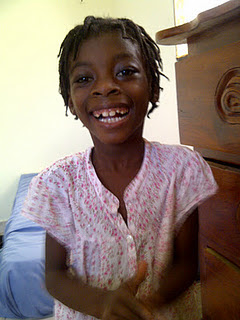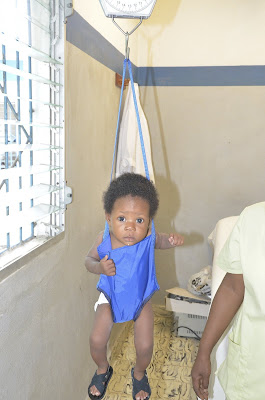 |
| (Photo by John Carroll) |
Last month this little man was my patient in a pathetic cholera tent in Robillard, Haiti.
Like most elderly Haitians when I asked him his age he could not give a definite answer. He did say that he was born during the United States Occupation of Haiti. So that means he was born somewhere between 1915--1934. So he is between 77 and 96 years old. My guess is that he is 93 years old, give or take a couple of years.
He was never married and has no children. He lives in a little ti kay in Robillard and is assisted as necessary by an elderly niece.
He was a farmer most of his life. And he sold livestock and produce.
When he was admitted to the tent, he was quite ill--dehydrated with vomiting and diarrhea. He was very weak and spent most of his day on the wooden cot with his niece attending to him. He would look around, but that is about all he did.
So we tanked him up with IV fluids and held our breath. Cholera is hard on old people.
As they days went by, he became stronger and began to stand at his cot side. And even though he was very hard of hearing, he wanted to be heard. So he would give little speeches in the tent to the amusement of the other cholera patients and families.
One day I asked him what he thought of the Americans occupying his country many decades ago. He said it was good because "if it weren't for Americans, we (Haitians) would not have clothes on our backs".
His philosophy is somewhat different than the article below which describes Haiti's painful history.
(We discharged this man from the tent after his vomiting and diarrhea stopped and he was eating and drinking. He left the tent with his little tree-branch-cane, happily talking, with his niece at his side.)
jc
Haiti--The Aftershocks of History
by Adam Hochschild
As a French possession, it was once the most lucrative colony on earth, producing nearly one-third of the world’s sugar and more than half its coffee. All, of course, with the labor of slaves. And slavery in the Caribbean was particularly harsh: tropical diseases were rife, there was no winter respite from 12-hour workdays under the broiling sun, and the planters preferred to replenish their labor force by working their slaves to death over a decade or two and then buying new ones.
In 1791, what today is Haiti became the scene of the largest slave revolt in history. Over the next 13 years, the rebels fought off three successive attempts to re-enslave them. The first was by local planters and French soldiers, aided by arms from the United States, whose president and secretary of state, George Washington and Thomas Jefferson, were both slave owners horrified by the uprising. The second was by the British, at war with France and eager for fertile sugar land and slaves to work it. And finally, after he took power, Napoleon tried to recapture the territory as a French colony and restore slavery.
Ill-armed, barefoot and hungry, the rebels fought against huge odds: Britain dispatched an armada of 218 ships to the Caribbean, and its troops battled for five years before withdrawing; Napoleon sent the largest force that had ever set sail from France, losing more than 50,000 soldiers and 18 generals to combat and disease.
The former slaves lost even more lives defeating these invasions, and no country came to their aid. This blood-soaked period also included a horrific civil war, periods of near famine, and the massacre or flight into exile of most educated people and skilled workers of any color. By the time Haiti declared independence in 1804, many of its fields, towns and sugar mills were in ruins and its population shrunken by more than half. The Haitian Revolution, as it is known today, was a great inspiration to slaves still in bondage throughout the Americas, but it was devastating to the country itself.
For a gripping narrative of that period, there are few better places to turn than “Avengers of the New World: The Story of the Haitian Revolution,” by Laurent Dubois, a Duke University scholar of the French Caribbean. Now Dubois has brought Haiti’s story up to the present in an equally well-written new book, “Haiti: The Aftershocks of History,” which is enriched by his careful attention to what Haitian intellectuals have had to say about their country over the last two centuries.
The history is a tale of much misery, shot through with flashes of hope and bravery. Both the United States and the colonial powers in Europe were profoundly threatened by the specter of slaves who had successfully battled for their freedom; the United States didn’t even recognize Haiti for over 50 years. Still worse, France in 1825 insisted that Haiti pay compensation for the plantations taken from French owners. In case the Haitians did not agree, French warships lay offshore. The sum the French demanded was so big that a dozen years later, paying off this exorbitant ransom, and paying the interest on loans taken out for that purpose, was consuming 30 percent of Haiti’s national budget. The ruinous cycle of debt continued into the next century.
Seldom, however, can outsiders be blamed for all a country’s troubles. More disastrous than foreign interference was that Haiti’s birth was such a violent one. Democracy is a fragile, slow-growing plant to begin with, and the early Haitians had experienced none of it, not as subjects of the African kingdoms where many of them were born, not as slaves and not as soldiers under draconian military discipline for over a decade of desperate war. In Haiti’s succession of constitutions over its first hundred years, the president sometimes held his post for life, and it’s no surprise that one leader began calling himself king and another emperor. Furthermore, the revolution itself had seemed to show that any change in government could take place only through military force. As Dubois sums it up: “The only way for an outsider to take power — one that would be used again and again over the course of the 19th century — was to raise an army and march on the capital.”
Brute force still ruled in the next century, climaxing in the three-decade reign of the Duvaliers, father and son. Their militia, the dreaded Tontons Macoute, spread terror on a scale exceeding anything before, murdering as many as 60,000 people. François (Papa Doc) Duvalier banned any civic organization that could threaten his control, even the Boy Scouts.
The family’s close ties with the United States were immortalized by a famous photograph of Papa Doc and the presidential envoy Nelson Rockefeller waving from the balcony of Haiti’s National Palace. During the cold war, a strongman like Duvalier, no matter how brutal, could usually count on American support as long as he was vocally anti-Communist. Father and son understood this well and shrewdly used that knowledge to retain power, as did petty tyrants across Latin America, Africa and Asia.
Deep American meddling in Haiti did not end with the cold war. Dubois, however, devotes only a few pages to the quarter-century since Jean-Claude (Baby Doc) Duvalier was overthrown, and doesn’t really tell us what he thinks about the controversial progressive Jean-Bertrand Aristide and the degree to which the United States played a role in his ouster as Haiti’s president in 2004. In an otherwise authoritative history, this is a disappointing omission.
Part of this book does feel chillingly up to date, however: its account of the United States Marine occupation of Haiti for some two decades starting in 1915. The occupation was accompanied by high-flown declarations of benevolence, but the real motive was to solidify American control of the economy and to replace a constitution that prevented foreigners from owning land. The Marines’ near-total ignorance of local languages and culture sounds all too much like more recent expeditions. American officials declared, accurately enough, that the Haitian government was in bad shape and needed reform.
But as the troops on the ground discovered, like their counterparts in Iraq and Afghanistan, no one likes to be reformed at the point of a foreigner’s gun. “We were not welcome,” wrote one private Dubois quotes. “We could feel it as distinctly as we could smell the rot along the gutters.” The Americans soon found themselves fighting off waves of rebellion against their rule. United States troops burned entire villages accused of sheltering insurgents and ruthlessly executed captured rebels or — does this sound familiar? — men who might have been rebels; often there was no way to distinguish them from local farmers.
When they finally pulled out, the Marines did leave some roads, clinics and schools behind them. But the occupation’s death toll, humiliation and theft of resources, Dubois makes clear, loom far larger in Haitian memory. Even with the best of intentions, which the Marines certainly didn’t have in 1915, nation-building is no easy job. Administered less arrogantly and in cooperation with Haitians themselves, aid from abroad can sometimes help, as with the work of the estimable, Creole-speaking Dr. Paul Farmer and his Partners in Health program, which brings health care to the poorest rural areas and helps train Haitian medical workers. But the real freeing of Haiti from the burdens of its past — a task now made immeasurably greater by the catastrophic earthquake of 2010 — can be done only by Haitians themselves.
 |
| (Photo by John Carroll) |
Adam Hochschild is the author of seven books, most recently “To End All Wars: A Story of Loyalty and Rebellion, 1914-1918.”




















